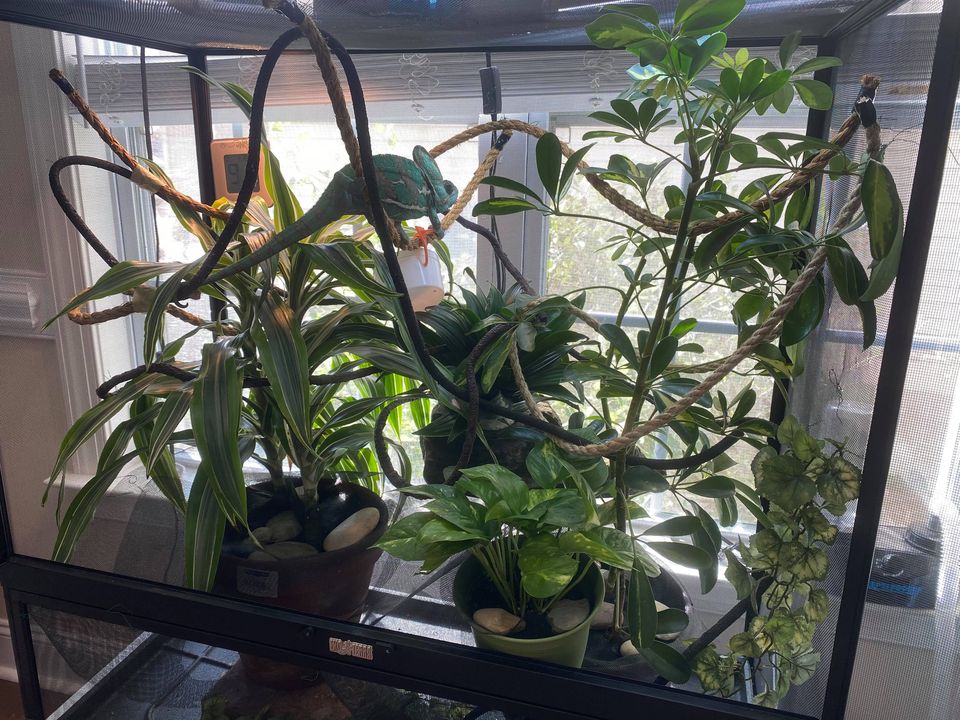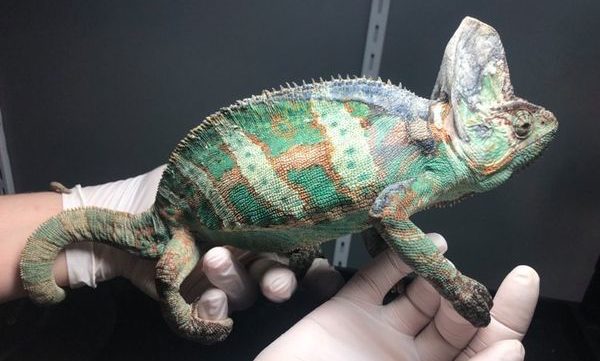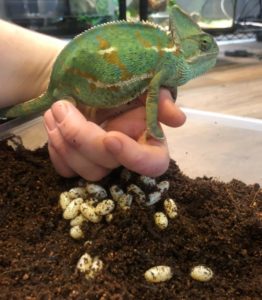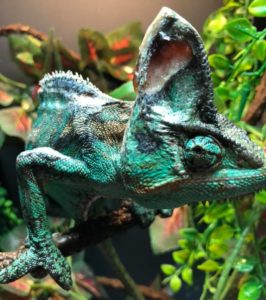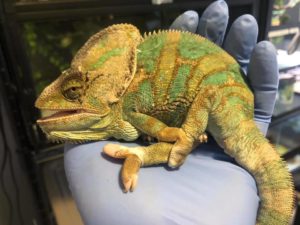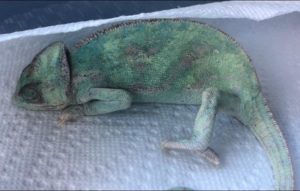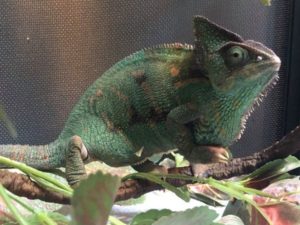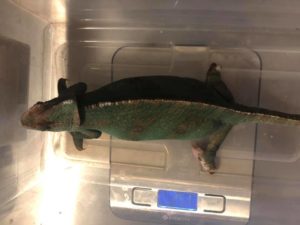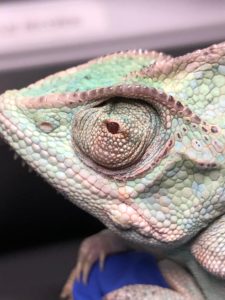VEILED CHAMELEON CARE GUIDE
Species name: Chamaeleo calyptratus
Lifespan: Males 6-8 years; females 4-5 years
Origin: Yemen and Saudi Arabia
Adult size: 9 in – 11 in
Caging
Caging: Chameleons are arboreal so their enclosure should have more vertical space than horizontal space. We recommend screen enclosures for most chameleons; glass enclosures are really only appropriate if the owner lives in an extremely arid climate, and modifications must be made to ensure proper airflow. We recommend a 2’ x 2’ x 4’ enclosure for most veiled chameleons, though some small females can do well in an 18” x 18” x 36” enclosure. Zoo Med and Exo Terra both have great options for large screen enclosures. Baby veiled chameleons should be started in a much smaller screen enclosure so they can appropriately find their food.
Decor
Chameleons should be provided with lots of foliage for climbing and hiding. Live plants are the perfect decor for chameleons, and some of our favorites include pothos and scheffleras. Fake plants can also be used to provide additional coverage. Chameleons are arboreal and will appreciate decor they can climb like the Exo Terra Jungle Vine, Fluker’s Bend-A-Branch, and reptile hammocks. Natural hardwood branches can also be used. Branches collected from outside should be thoroughly washed, left outside to dry in the sun, and sanded if necessary. The main basking spot should be approximately 10-12 inches away from their UVB light and basking light.
Substrate
Beginner keepers should use paper towels at the bottom of their cage. These are easy to replace when soiled and allow you to closely monitor their waste. Chameleons can be kept on a bioactive soil mix, but this should only be attempted by experienced chameleon keepers.
Lighting
Chameleons are extremely susceptible to metabolic bone disease, so their UVB lighting needs to be perfect. They require a T5 linear UVB bulb that is at least 22 inches long. Popular choices include the Zoo Med Reptisun T5HO 10.0 and the Arcadia T5 12%. Coil bulbs are NOT acceptable for a bearded dragon; the amount of UVB light produced is much lower and the light only reaches a few inches under the bulb. T8 linear bulbs also are not recommended as they’re weaker and the basking spot needs to be much closer for them to be effective. The UVB bulb needs to be changed every 6-12 months, as they stop producing UVB light even though they still produce visible light.
Heating
Chameleons are susceptible to burns if their heat lamps are too strong or too close to their basking spot. NEVER use reptile basking bulbs from the pet store, they are too strong. The only bulbs we recommend are incandescent BR30 or BR40 household flood bulbs – they can be purchased from your local hardware store or online. Flood bulbs should be used in conjunction with a deep dome.
Humidity
The humidity level should range between 40% and 90%. It should be reduced during the day and increased during the morning and evening. To achieve this, mist in the morning and night. A dry-out period during the day is crucial to their health. The misting can be done manually with a reptile pressure sprayer or with an automatic misting system. Popular misting systems include the MistKing and ExoTerra Monsoon. Do not mist the chameleon directly, just the surrounding decor and plants. Some keepers choose to use a fogger as well, however it is not strictly necessary and should only be used for 1-2 hours late at night.
Hydration
Chameleons will only drink moving water, so a bowl of water is not necessary. Hydration is provided with the morning and evening misting. A dripper (like the ZooMed Big Dripper) should also be provided. A common mistake with beginner keepers is to let the dripper run all day – this will flood your cage. Fill the dripper with only 1 cup of water and allow it to drip at 1 drop per second during the morning and/or evening. The dripper should be placed so that the drops fall onto a plant or into an empty bowl.
Diet
As is the case with many reptiles, the key to a healthy diet is variety! Dubia roaches, crickets, superworms, wax moths, black soldier fly larvae, silkworms, and flies can all be fed regularly. Many keepers procure moths by allowing waxworms to pupate. Hornworms and waxworms can also be fed as occasional treats. Butterworms and mealworms are not recommended for chameleons. Very young chameleons should be fed daily and the frequency of feeding should gradually decrease. By the time they are fully grown adults, they only need to be fed 3-4 days a week. Chameleons will sometimes consume produce, but it is not necessary to their diet. It can be offered occasionally, but insects should make up the vast majority of their diet. Their insects should be gut-loaded prior to feeding them to your chameleon.
Supplementation
Insects should be dusted with calcium WITHOUT D3 before every feeding. A multivitamin should be used twice a month. Appropriate multivitamins include Reptivite with D3, Repashy Calcium Plus, or Repashy Calcium Plus LoD. Powdered bee pollen can also be added to their calcium without D3, but is not required. Mix it into the calcium without D3 at 1:8 ratio – so for every 1 teaspoon of calcium, add 1/8 teaspoon of bee pollen.
Sexing
Male chameleons have a larger casque and a noticeable tarsal spur. A tarsal spur is a bump on the back of the hind feet.
Lay Bin
Female chameleons will lay infertile clutches without ever being exposed to a male. If you suspect your female chameleon is gravid, you will need to provide it with a lay bin. The ideal lay bin should be approximately 10-12 inches wide and at least 12 inches deep. Choose an opaque container so your chameleon feels secure. Fill the lay bin to the top with a mixture of sand, soil, and a little water. The mixture should be damp, but not dripping. The substrate should be able to hold a tunnel, as your female will dig to the bottom of the lay bin before laying her clutch. We like to place the lay bin under some foliage to provide it with some cover. Some keepers choose to keep a lay bin in the enclosure at all times.
Things You Should NOT Do
Cohabitate: Chameleons are solitary animals and once they reach adulthood they should not be cohabitated with other chameleons. Keeping two chameleons in the same enclosure can cause stress and often aggression. Even breeders typically introduce their pairs for only a short while before separating them.
Use a Reptile-Branded Heat Bulb: Do not buy your heat bulb from a pet store. While these bulbs are appropriate for many species, they are too strong and concentrated for chameleons. We have received chameleons with severe fourth degree burns from reptile-branded bulbs that required significant medical attention and eventually euthanasia.
Over-Handle: Chameleons are typically NOT sociable reptiles. There are exceptions to every rule, but the majority of chameleons do not enjoy being handled by humans. When handled, some chameleons will puff up, hiss, close their eyes, turn a dark color, or act lifeless. All of these behaviors are indicators of stress. Some chameleons will even fall asleep while being handled – while this may be a sign of trust in other species, it’s actually a sort of defense mechanism for chameleons. While minimal handling is OK and your chameleon may get more used to you over time, think of veiled chameleons as more of a “display pet.” These do NOT make good program animals and are inappropriate pets for most children.
Buy a Chameleon Kit: The Zoo Med Reptibreeze Chameleon Kits are sold in almost every pet store and often marketed as a perfect solution for a new chameleon owner. These kits are NOT acceptable and your chameleon WILL develop metabolic bone disease if you use the kit. The enclosure is too small for most adult chameleons, they do not contain enough decor or foliage for a chameleon to feel secure, and the UVB lights are inappropriate. A proper chameleon setup will easily cost $300-$400+, and there is no way around buying the proper lighting, caging, decor, and mister.
Common Health Issues
Metabolic Bone Disease: Metabolic bone disease, also called nutritional secondary hyperparathyroidism, is most commonly seen in pet reptiles and is caused by nutritional deficiencies and a lack of UVB light. Captive chameleons require supplemental calcium dusted on their feeder insects, gutloaded insects, and a high powered ultraviolet light. Vitamin D3 is also needed in conjunction with calcium, or else the animal cannot process the calcium internally. MBD is unfortunately very common in chameleons, and we have seen many MBD chameleons surrendered to us over the years. The “chameleon kits” sold in pet stores do NOT contain the correct UVB light, among other issues. Because of this, many pet store chameleons end up developing MBD – in fact, we’ve even had a pet store surrender a chameleon with MBD to us.
Signs of MBD include curved legs, a curved or soft jawbone, lethargy, poor tongue function, and anorexia. If you think your chameleon may have MBD, seek veterinary assistance IMMEDIATELY. Your veterinarian will give you a special prescription liquid calcium and may want to take X-rays to check for fractures in your chameleon’s bones. You should immediately fix all husbandry issues and start following the above diet, supplementation schedule, and light source exactly. Buy a brand new 10% T5HO UVB bulb, as they do stop output between 6-12 months. Please contact us if you have any questions on the specifics or don’t know where to buy specific supplements and equipment. Chameleons go downhill quickly and if you want to save your chameleon, you must be prepared to seek veterinary care immediately.
Gout: Chameleons do not drink water from a dish like most pets, so they are prone to dehydration and kidney issues in captivity. Chronic kidney issues can lead to the formation of uric acid crystals that form in the tissues. These are commonly seen in the joints, though gout can also form in the internal organs. Gout can also be caused by diets that are too high in protein. Make sure that you are feeding your feeder insects an appropriate diet that includes grain-based insect feed and fresh vegetables, not a high-protein feed such as dog or cat food. If your chameleon has swollen joints, is lethargic, anorexic, or not walking well, see your veterinarian immediately. They might do X-rays or take a fine needle aspirate of one of the masses, which they can look at under the microscope to see uric acid crystals. If you catch this early, sometimes the chameleon can be healed with allopurinol and proper hydration. However, in advanced cases typically this isn’t curable. Gout is also a very painful disease, so pain management should be considered.
Renal disease: Chameleons do not drink water from a dish and need alternative water sources. You should use a dripper and a mister to ensure your chameleon is getting proper hydration. Signs of kidney disease include lethargy, sunken in eyes, problems shedding, and anorexia. This can be fatal, so seek veterinary assistance immediately if you suspect your chameleon has kidney disease. Your veterinarian will run a blood test and may prescribe extra fluids for hydration.
Gular Edema: This is essentially fluid swelling in the throat area. Gular edema is a complex condition that can have many different causes. This is often caused by over-supplementing vitamins A and D3; as a reminder, vitamins A and D3 should only be offered twice a month. If you are following the correct supplementation schedule and are still seeing gular edema, use only calcium for at least a month, while still offering healthy, gut-loaded feeder insects. Gular edema can also be caused by dehydration, so ensure that your chameleon has access to a mister and dripper daily. Some females will apparently have gular edema when they are heavily gravid or laying eggs, which should go away by itself within a few weeks. If your chameleon has gular edema, first try cutting back on supplements and making sure it has the correct water sources. If this issue persists, see a veterinarian for blood tests and a full examination, as other causes can include liver and heart disease.
Egg Binding/Dystocia: Egg Binding/Dystocia: Female chameleons typically lay infertile eggs yearly, which takes a toll on their bodies and shortens their lifespans. If you have a female chameleon, you should be prepared for her to lay a clutch of eggs every summer by providing her a large laybox with appropriate substrate. Under appropriate conditions, most chameleons lay their eggs just fine. However, they may become “egg bound” or have dystocia, particularly if they are already having the following issues: metabolic bone disease, calcium deficiency, overfeeding, and lack of an appropriate lay box. If your chameleon is obviously gravid but her health has started to decline and she has not laid her eggs, she may be egg bound. Symptoms can include anorexia, weight loss, dark color, and sunken in eyes as they lose energy and refrain from eating or drinking. If the eggs or follicles stay in her for too long, it’s also possible for them to become infected, which can lead to sepsis. If your chameleon is gravid, not laying eggs, and has declining health, bring her to an experienced exotics veterinarian IMMEDIATELY. The veterinarian will take X-rays to determine the condition of the eggs and to see if they’re completely calcified or not, and may prescribe you supportive care such as fluids, medication to induce laying such as calcium and oxytocin, or suggest a surgery to remove the eggs and possibly spay the chameleon. Surgeries are required in some cases.
Hypovitaminosis A: Just like calcium, chameleons need supplemental vitamin A in their diets. In chameleons, this typically presents as eye problems, including swollen eyes, squinting, and mucous. The chameleon may also have issues shedding completely and may have abrasions or irritation around the lips. When there isn’t enough vitamin A, cells start to thicken and many of the glandular or mucosal areas, such as the eyes, mouth, and tongue, become more keratinized. If your chameleon’s tongue is no longer sticky or if it cannot use its tongue, it’s possible it has hypovitaminosis A. These symptoms can result in systemic problems for the animal, such as chronic eye infections, anorexia, and problems shedding. If you suspect your chameleon may have hypovitaminosis A, bring it to an experienced exotics veterinarian immediately for an examination. The vet may want to do bloodwork to assess general organ function. Your veterinarian will probably prescribe a vitamin A supplement and may give you an antibiotic solution for the eye to prevent secondary infection. Many cases require the veterinarian to go in manually and clear out the eyes of debris. Chameleons can go downhill VERY quickly, so it’s important to seek veterinary assistance as soon as possible.
Parasites: Chameleons can carry many different types of parasites, including pinworms, coccidia, spirochetes, and protozoans. It is common for chameleons to have a small level of parasites, this is normal for their gut flora. However, when a chameleon is sick or stressed, the parasites can take over and cause diarrhea, weight loss, and anorexia. This can become serious, so bring a fecal to your veterinarian if your chameleon is exhibiting the above signs. If your chameleon was purchased from a pet store, it is likely wild-caught and more likely to carry parasites. Any wild caught reptiles should have fecals done when they are brought home.
Prolapse: Cloacal prolapses can happen in both male and female chameleons, but male chameleons can also get hemipenal prolapses. A prolapse is an emergency that should see a veterinarian immediately. If it is recent, sometimes the vet can push the prolapsed tissue back in and place a temporary suture, but advanced prolapses can become infected and necrotic. Some prolapses will require amputation, especially if they are not treated quickly.
Mouth Rot: Mouth rot is a condition where the mouth develops a bacterial infection. This can be due to a dirty water source or dirty enclosure, a wound in the mouth that becomes infected, or stuck shed around the face. Mouth rot can quickly become serious, as it is painful and will cause the chameleon to not want to eat. You should see a veterinarian to clean out the mouth and start an antibiotic regimen. Make sure to always maintain a clean environment.


